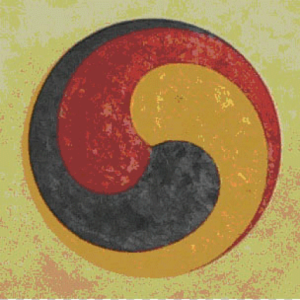
I’ve taken a deeper dive into ayurveda this year. This exploration has been a chance to return to a study and experience of the subtle body that just becomes more important and interesting the longer I practice and the older I get.
Ayurveda (remember, a kindof “sister science” to yoga but really so much more) looks at life and the body as expressions of nature, so it considers life, the body and nature as constituted of the same matter and energetic qualities. The gunas are ways to distinguish and describe those qualities. Everything -every – thing – I am, everything I am in contact with and connected to (including my mind and the thoughts and impressions contained therein) is composed of matter and energy. The “matter” part is made up of what we know familiarly as the five elements (air, water, fire, earth or space/ether). Both matter and energy can then be described as exhibiting specific and variable qualities (e.g., air is “light”; water is “fluid”; fire is “hot”; earth is “heavy”; ether is “clear”). All matter is composed of these elements brought into endless combinations and recombinations.
With me?
The gunas then, are ways of categorizing these combinations of qualities in order to help us see our experience of ourselves and of our relationships and interactions with our environment. So:
Tamas – stability, stasis, darkness, dullness, heaviness, insentience, obstructing, veiling
Rajas – activity, motion, energy, movement, changing
Sattvas – existence, light, illumination, sentience, harmony, clearing
Think about the food you eat in this way. In ayurveda, foods are categorized according to these qualities. Heavy, cold, difficult to digest foods like red meats, processed, fortified and refined foods, frozen foods, or old foods/leftovers are tamasic. Rajasic foods are hot, spicy, acidic and would include coffee, alcohol, fermented and pickled foods, chilies, fried foods and eggs. Sattvic foods would include the sweet, nourishing, balanced, easily digestible, natural and fresh (or lightly cooked) foods such as fruits, vegetables, legumes, milk, nuts, ghee (clarified butter). Sattvic foods can be made more rajasic or tamasic as necessary to address depletion and imbalances (more on that to come…).
So with our foods, so with our body/mind. Think about the varying qualities of your moods, thoughts and emotions. The times you feel dull or depressed, or restless, energized or even anxious; or calm, centered and loving. Aim to include more sattvas in your daily food routine. All the food and nutrition experts encourage it, science supports it.
Remember the gunas describe qualities of matter and energy – they describe us. We are an embodiment of an ongoing creative impulse, and are co-extensive with the rest of the world around us. The quality of what we ingest of the world in the form of sustenance is reflected in our bodies and our outlook, our subjectivity, our view of ourselves and relatedness with others.